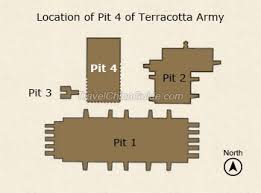
What's Inside the Terracotta Army Pit 4?
To date, four pits have been partially excavated at the burial site of China's First Emperor, Qin Shi Huang. Three are filled with the terra-cotta soldiers, horse-drawn chariots, and weapons intended to serve the emperor in the afterlife. The fourth pit is empty, a testament to the original unfinished construction.
The Significance of an Empty Pit
The emptiness of Pit 4 is a source of much speculation and debate among archaeologists and historians. Some believe it was intended for a specific purpose, such as housing the emperor's concubines or servants, while others suggest it was left unfinished due to time constraints or a change in plans.
Despite its lack of contents, Pit 4 is far from insignificant. Its very existence provides valuable insights into the scale and ambition of the Terracotta Army project. The pit's dimensions – a staggering 200 meters long, 96 meters wide, and 5 meters deep – suggest that it was intended to hold an equally impressive display, perhaps even surpassing the other three pits in terms of grandeur and complexity.
Possible Explanations for the Emptiness
Several theories attempt to explain the enigmatic emptiness of Pit 4:
- Unfinished Construction: The most straightforward explanation is that the pit was never completed. The construction of the mausoleum complex was a massive undertaking, spanning several decades and requiring the labor of hundreds of thousands of workers. It's plausible that Qin Shi Huang's death in 210 BCE interrupted the project, leaving Pit 4 unfinished.
- Symbolic Purpose: Some scholars propose that the empty pit held a symbolic meaning. It might have represented the underworld or a realm yet to be populated by the emperor in the afterlife. This theory draws on ancient Chinese beliefs about the afterlife and the emperor's role as a mediator between the human and spiritual worlds.
- Lost or Degraded Contents: Another possibility is that Pit 4 originally contained perishable materials like wood, textiles, or even human remains. These materials would have decayed over time, leaving behind an empty pit. This theory is supported by the presence of traces of organic materials found in other parts of the mausoleum complex.
Ongoing Research and Future Discoveries
Archaeological work at the Terracotta Army site is ongoing, and researchers continue to uncover new clues about the purpose of Pit 4. The discovery of additional artifacts, such as tools, pottery shards, or architectural features, could shed light on the original construction plans and the pit's intended use.
Advances in archaeological technology, such as ground-penetrating radar and remote sensing, are also being employed to investigate the subsurface features of Pit 4 without disturbing the site. These non-invasive techniques could potentially reveal buried structures or artifacts that provide further clues about the pit's history and significance.
Q&A
Q: Are all of the pits open to the public?
A: No, while Pits 1, 2, and 3 are open for public viewing, Pit 4 remains closed to visitors. This is primarily to protect the site and allow for ongoing archaeological research.
Q: If they haven't excavated Pit 4, how do they know its dimensions?
A: Archaeologists have used non-invasive techniques like ground-penetrating radar to map out the boundaries and depth of Pit 4 without excavating it.
Q: Is there a plan to fully excavate Pit 4 in the future?
A: Currently, there is no set timeline for the full excavation of Pit 4. Chinese authorities are taking a cautious approach, prioritizing preservation and research before any major excavation work is undertaken.